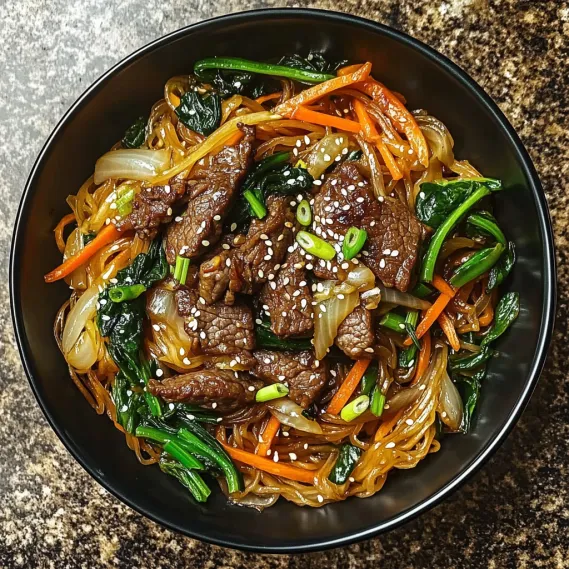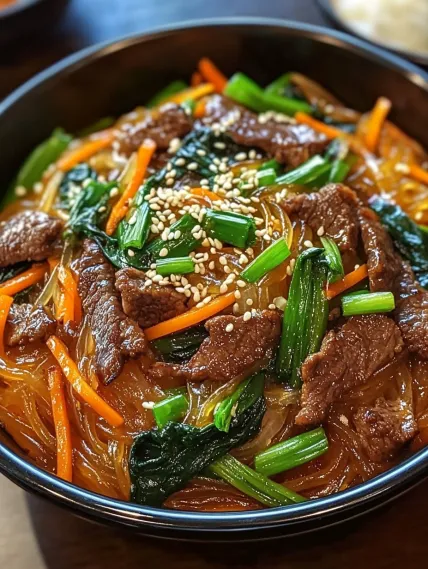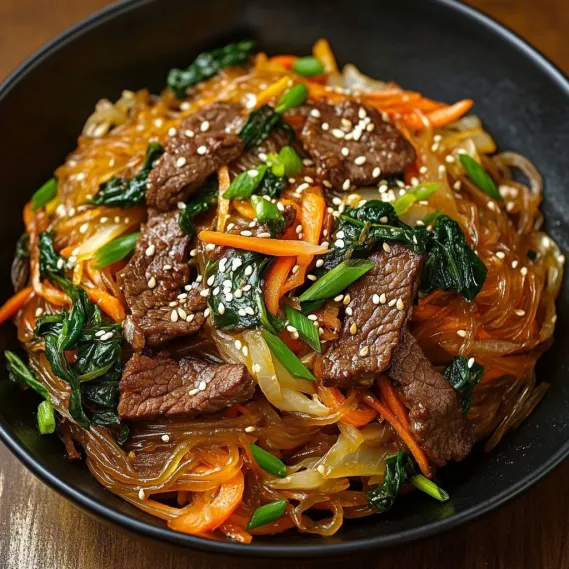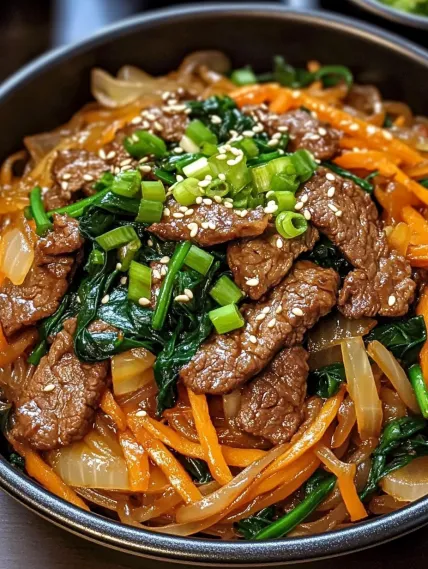 Pin it
Pin it
Sweet potato glass noodles meet succulent beef slices and fresh veggies in this perfectly balanced dish where sweet meets savory. Japchae stands out with its uniquely stretchy noodles combined with crisp veggies and juicy beef, all wrapped in a shiny sauce full of nutty sesame oil and umami soy flavors. The bright mix of matchstick carrots, wilted spinach, and thinly cut onions makes this Korean favorite a feast for your eyes and provides layers of goodness that'll satisfy both your hunger and your interest in true Korean food.
After coming home from visiting Seoul where I couldn't stop eating this noodle dish, I tried making japchae myself. My first try was awful – soggy noodles and mushy veggies. It took several attempts and tips from a Korean buddy before I figured out the key trick: cook everything separately before mixing it all together. Now it's what I make when friends come over, and they're always blown away by how much flavor comes from such basic ingredients.
Key Ingredients and Smart Selection Advice
- Sweet Potato Glass Noodles: These see-through noodles are what makes the dish special. You'll find them at Asian markets or online shops. Don't try using rice or wheat noodles instead – they won't give you that bouncy chew that's so important.
- Beef: Go for thin slices of ribeye or sirloin. Pop the meat in the freezer for 20 minutes before cutting to get super-thin slices that cook quickly and stay soft.
- Vegetables: Mix in bright options like carrots, spinach, and onions. Cut everything about the same size so they cook evenly and look pretty together.
- Sesame Oil: This fragrant oil brings that nutty taste that's key to real japchae. Go for pure sesame oil, not mixed versions.
- Soy Sauce: This creates the savory base for your sauce. Pick low-sodium types if you're cutting back on salt.
I've noticed spending a bit more on really good sesame oil totally transforms the dish. The deep, toasty flavor from top-quality sesame oil lifts the whole meal and creates that true Korean taste that has everyone grabbing seconds.
Step-by-Step Cooking Guide
- Step 1: Get Your Noodles Ready
- Get a big pot of water boiling. Drop in the sweet potato noodles and let them cook for 5-6 minutes until they're soft but still have some bounce. Don't let them get mushy – they should fight back a little when you bite them. Drain them and run cold water over them to stop them cooking more.
- Step 2: Prep and Cook the Meat
- Mix your thin beef slices with some soy sauce, sesame oil, and brown sugar in a bowl. Let it sit for 10 minutes while you deal with the other stuff. Get a big skillet or wok really hot and cook the beef until it browns. Take it out and set it aside.
- Step 3: Handle the Veggies
- Using that same pan, add some olive oil. Cook each veggie on its own: start with carrots until they soften a bit, then onions until you can see through them, then garlic, and finish with spinach just until it shrinks down. Take each one out as you finish it.
- Step 4: Mix Up the Sauce
- In a little bowl, stir together the leftover soy sauce, sesame oil, and brown sugar until the sugar melts away. This well-rounded sauce will coat everything with that perfect sweet-savory mix that makes japchae so addictive.
- Step 5: Throw It All Together
- Put the noodles back in the pan over medium heat. Pour your sauce over them and toss until they're all coated. Add in your cooked beef, veggies, and green onions, gently mixing everything until it's all warmed up and combined.
- Step 6: Final Taste Check
- Give it a taste and add salt if needed. Everything should taste rich and balanced, with tender noodles and flavorful beef.
 Pin it
Pin it
The best moment I had with this dish was when I made it for my daughter's graduation party. A bunch of Korean guests came up to me surprised, saying it tasted just like their moms made it. My trick was cooking all the veggies separately to keep their bright colors and right texture, then letting the finished dish sit for an hour before serving so all the flavors could mix properly.
 Pin it
Pin it
Amazing Ways to Enjoy Japchae
Japchae can be so much more than just its classic form – you can switch it up from side dish to main event with a few tweaks. I've found mushrooms make a fantastic addition, especially shiitakes with their meaty feel and woodsy taste that works so well with the sweet-savory sauce. In summer, I throw in some thin-sliced bell peppers for extra snap and color. When hosting family with different eating habits, I'll make a big batch of noodles and veggies, then set out protein choices on the side – traditional beef, chicken, shrimp, or tofu. This make-it-your-way approach has turned japchae night into a monthly thing at our house, with everyone fixing their bowl just how they like it.
Getting Those Noodles Just Right
It took me several tries to really understand sweet potato noodles and their quirks. They're not like regular pasta – they keep soaking up liquid even after cooking, which can turn them into mush if you're not careful. My big breakthrough was cooking them just until they had a little bite left, then quickly washing them with cold water to stop them cooking. Tossing them with a bit of sesame oil not only keeps them from sticking together but starts adding flavor right away. Now when I add the sauce, I just warm everything through instead of simmering it, which keeps the noodles bouncy instead of soggy. My husband used to prefer rice dishes but now asks for japchae all the time, and always mentions the 'perfect noodle texture' as the reason why.
Creating Harmony in Taste and Look
Korean cooking really focuses on balance – not just how things taste but also how they look and their nutritional value – they call this concept 'banchan.' I've taken this idea to heart when making japchae, making sure each veggie isn't just there for flavor but adds to a beautiful color mix and brings different nutrients. The deep spinach greens, bright orange carrots, and purple-white onions don't just look pretty – they signal all the different good stuff in your meal. I've noticed even my son who usually picks around veggies eats everything in his japchae without complaint – the flavors work so well together that every bit seems like it belongs there. When I teach cooking classes at our community center, japchae is my favorite example of how careful prep makes food both beautiful and delicious.
Finding Culture Through Cooking
Making japchae has grown into something bigger than just cooking a tasty meal – it's opened up Korean culture for our whole family. After learning this dish came from royal courts during the Joseon Dynasty, we got curious about other Korean traditions and history. We now celebrate Korean festivals like Chuseok (their harvest celebration) with japchae as the main dish. My kids have learned about why the colorful presentation matters – it stands for harmony and good luck. What started as just trying a new recipe has turned into real cultural appreciation, with Korean cookbooks now filling our shelves and Korean TV shows becoming our Friday night family viewing.
Handy Cooking Hints
- Get all your ingredients ready before you start cooking – good prep is crucial for this quick-moving dish
- Sprinkle toasted sesame seeds on top just before serving for extra crunch and that authentic finish
- When feeding a crowd, prep everything ahead and mix it all just before eating
- Want some heat? Add a spoonful of gochujang (Korean chili paste) to your sauce
- If serving as your main course, up the meat to 2.5-3 pounds for 10 people
I found out how important it is to let the finished dish rest when my first try ended up kind of dry. Those few extra minutes make all the difference in how creamy everything turns out.
Smart Spending Meal Ideas
This meal shows how smart cooking can save money while making something fancy when meat like chicken or steak goes on sale. When I see cube steak marked down, I grab extra and freeze some just for this dish. The other stuff you need lasts ages in your pantry, so you can make restaurant-quality food at home for way less than takeout costs.
Making It Work for Everyone
Homes with different food preferences will love how easy this recipe adapts. Kids who turn up their noses at certain veggies often enjoy this because the pasta soaks up that yummy mushroom flavor. Sprinkle some cheese on top for picky eaters, or add extra veggies like peas or corn to boost nutrition. Think of the basic recipe as your starting point that can change to make everyone at your table happy.
Using What's Fresh Each Season
This flexible main dish works great with whatever produce is in season. Summer brings fresh corn or zucchini options. Fall is perfect for adding roasted butternut squash or mushrooms. Winter versions can use hearty root veggies. Spring calls for tender asparagus tips and fresh peas. These changes keep meals interesting all year while using what's fresh and cheap at your local market.
Tips for Busy Days
For hectic households, this recipe really shines as something you can prep ahead. You can make the pasta and sauce up to three days early and keep them in the fridge. If you need longer storage, the finished dish freezes well for up to three months. When you're ready to eat, just thaw it in the fridge overnight before baking as directed, adding just 1-2 minutes to your cooking time.
Expert Kitchen Advice
- Add a dash of dried thyme or rosemary to your mushroom mix for extra flavor punch
- Lightly brown your potato chips before using them to make them even crispier
- Toss in a bit of cayenne pepper with your mushrooms if you want some heat
- For thicker sauce, mix 1 tablespoon cornstarch with 2 tablespoons cold water and stir it in during the last 5 minutes
- This tastes even better the next day as leftovers
I worked out these little improvements after making this dish many times – especially adding rosemary, which gives an amazing depth of flavor without anyone being able to point out it's rosemary.
 Pin it
Pin it
This flexible tuna pasta bake has become my reliable standby when I need something everybody loves. The mix of soft pasta, creamy sauce, and crunchy potato chips creates something that's more than just the parts – it feels like comfort food that's surprisingly easy to throw together.
This tuna noodle bake shows that tasty, filling meals don't need fancy techniques or weird ingredients – just careful handling of good basics that work perfectly together.
Frequently Asked Questions
- → What are sweet potato starch noodles, and where do I get some?
- Sweet potato noodles (dangmyeon) are elastic and chewy, made from sweet potato starch. Look for them at Asian stores, Korean markets, or online labeled as 'glass noodles.'
- → Can I skip the beef and keep it vegetarian?
- Of course! Just leave out the beef and load up on veggies like mushrooms (shiitake fits well), bell peppers, or zucchini. You can add tofu for extra protein too!
- → What’s the best way to store leftovers?
- Put your leftovers in an airtight container and keep them in the fridge for about 3-4 days. Noodles soak up sauce, so just stir in a tiny bit of soy sauce and sesame oil when reheating.
- → Why are my noodles sticking together?
- They might have overcooked or sat too long. To avoid this, rinse them in cold water after boiling and coat in sesame oil. Add them to the pan last when stir-frying.
- → Can I make this dish ahead for a party?
- Totally! This dish tastes amazing made a day before. Store it covered in the fridge, let it come to room temp, then mix in some sesame oil just before serving.
